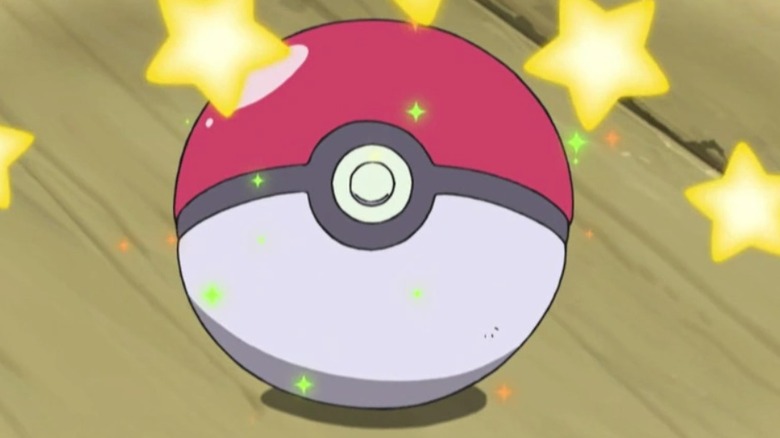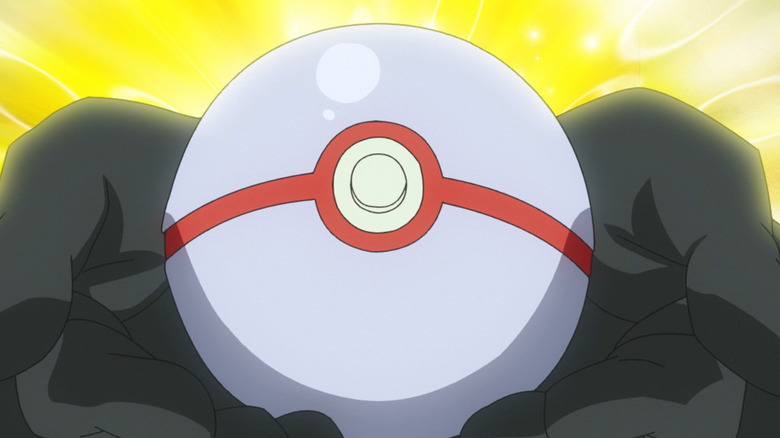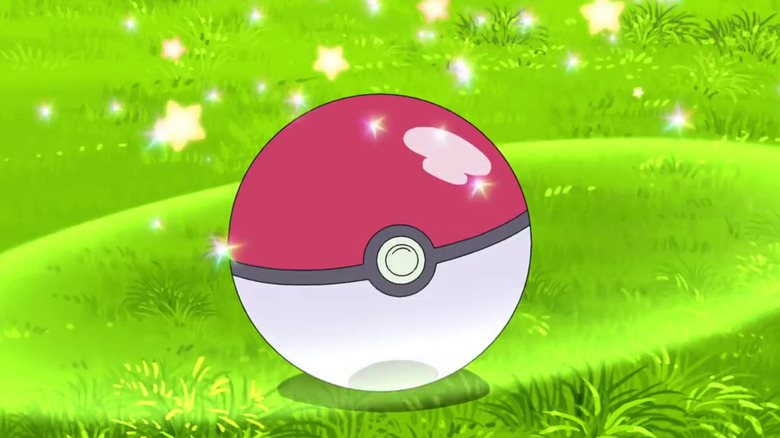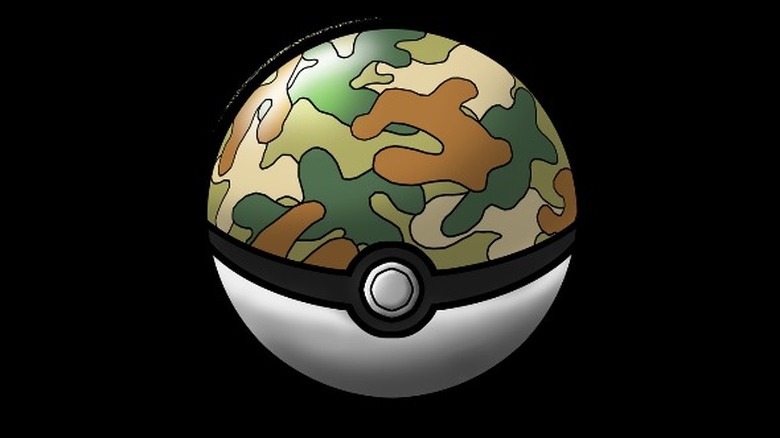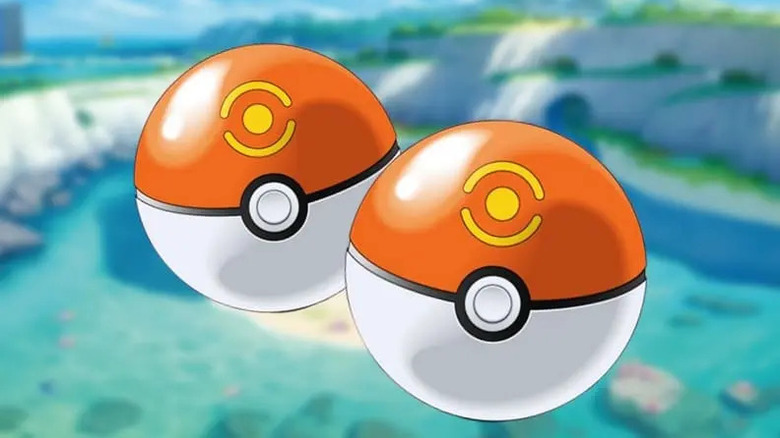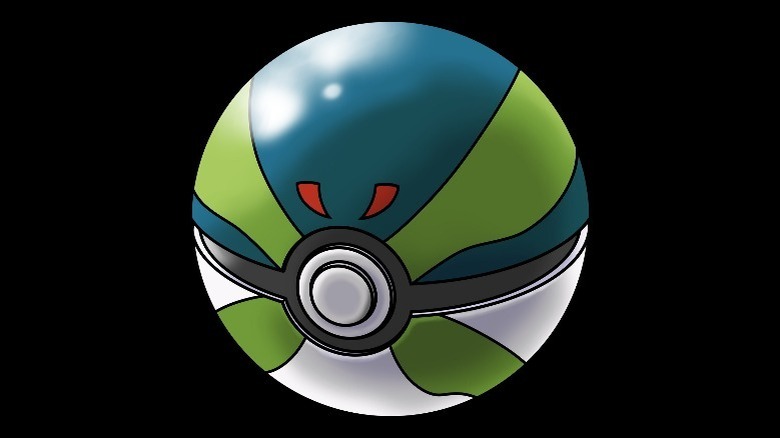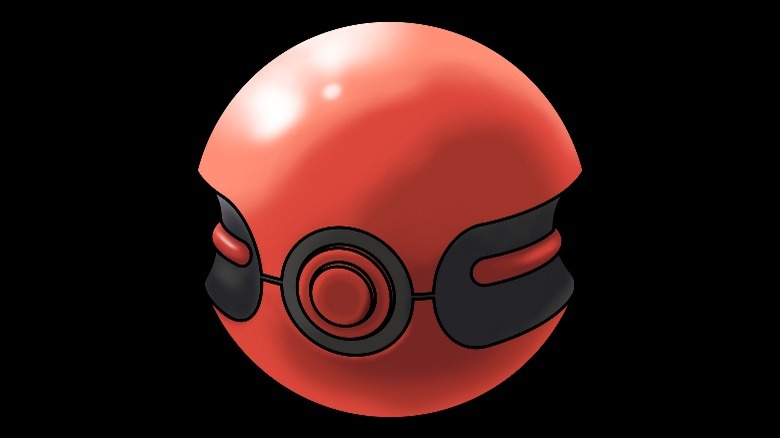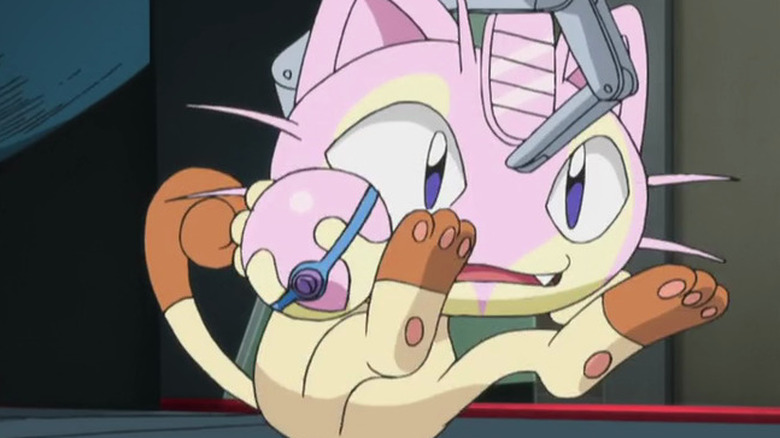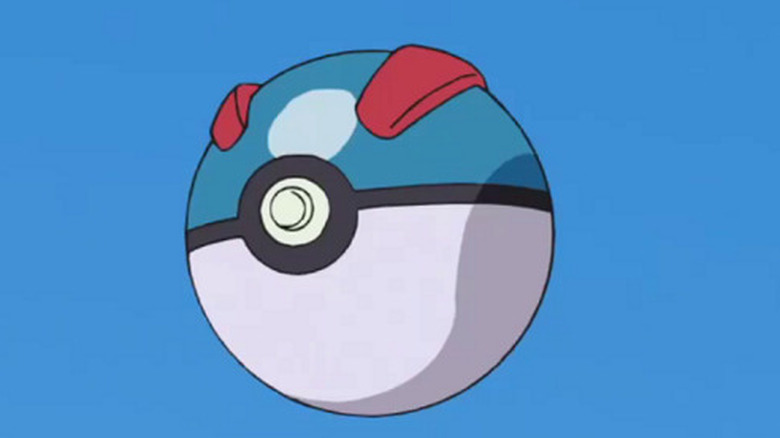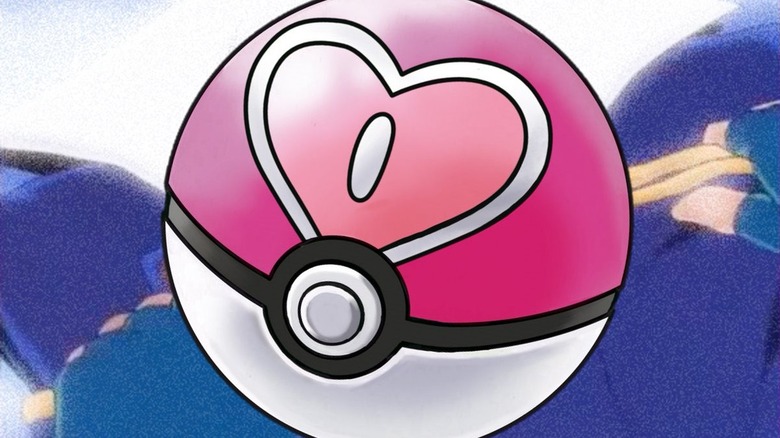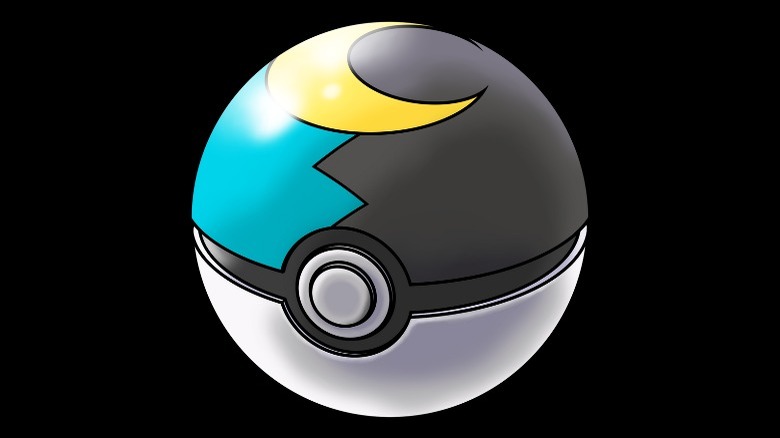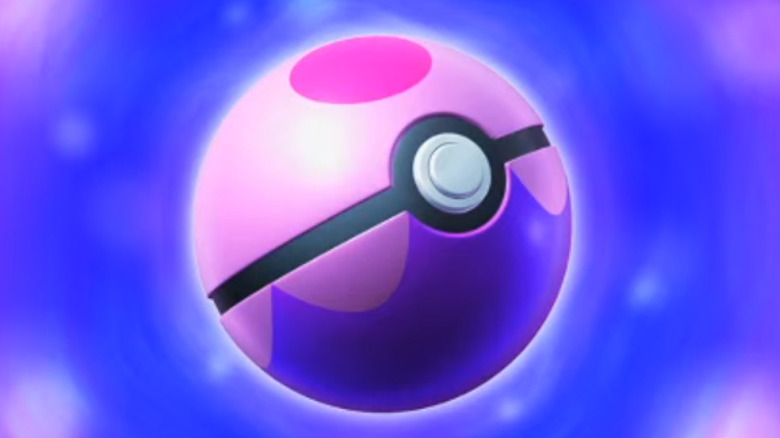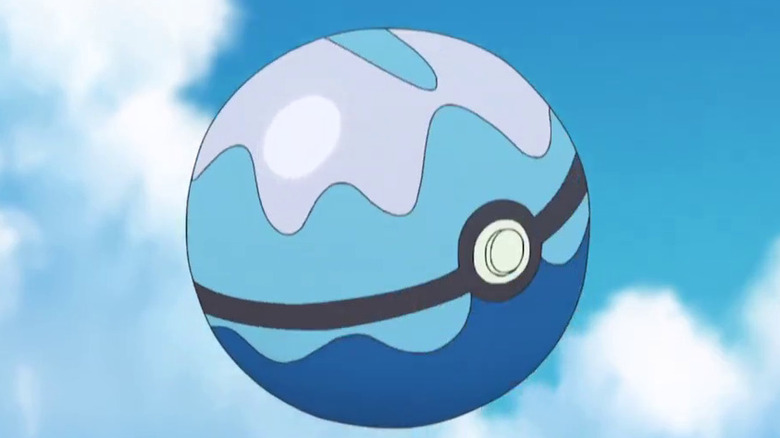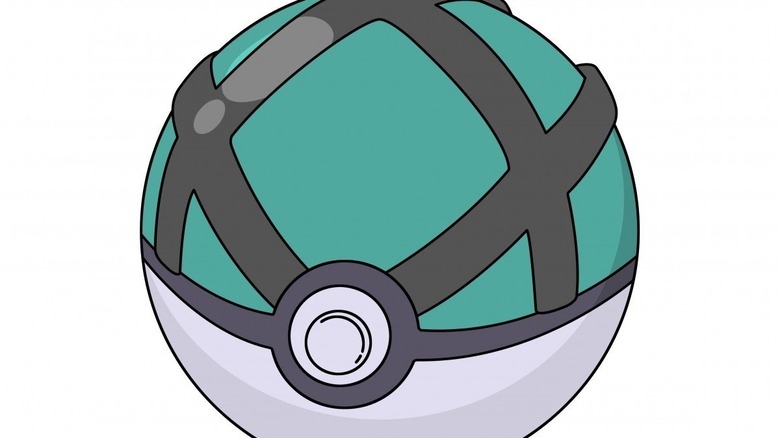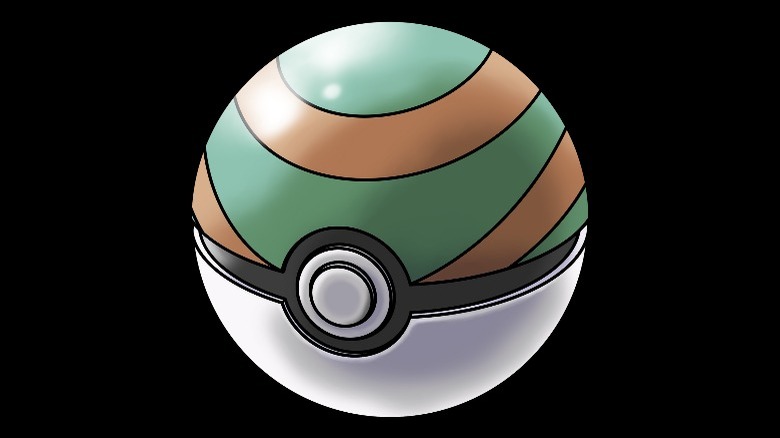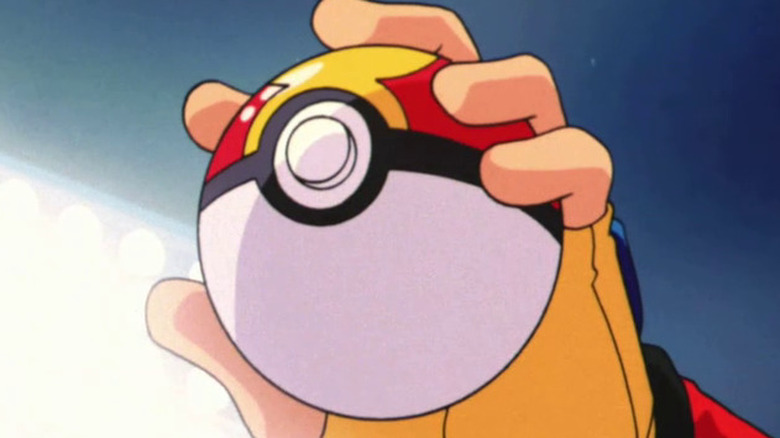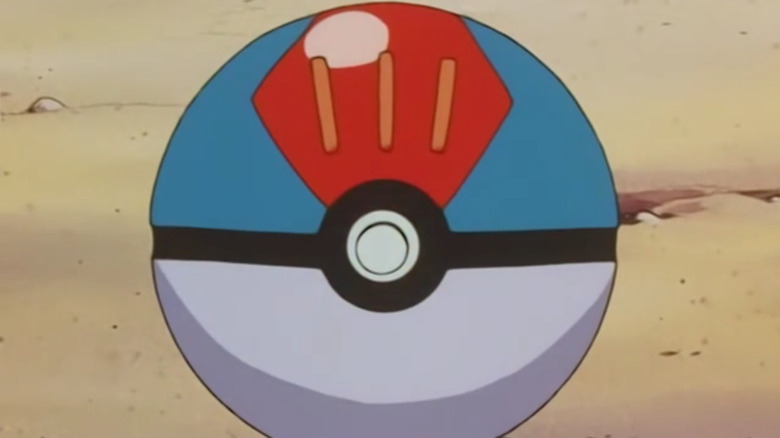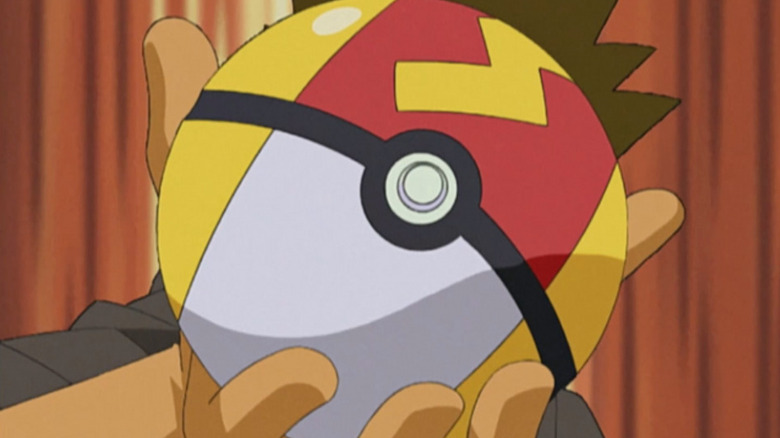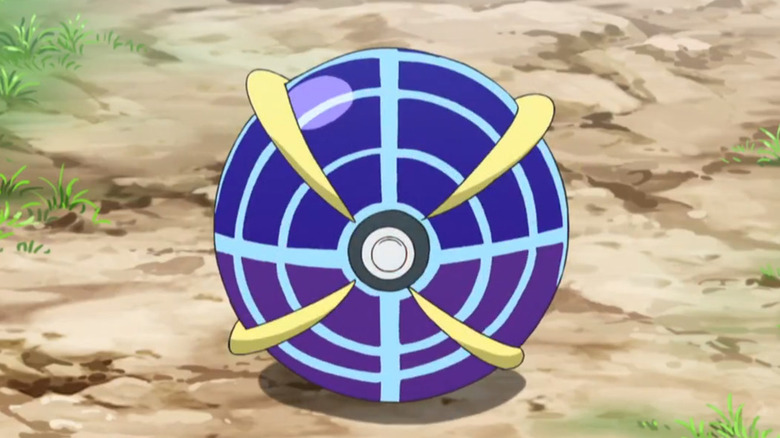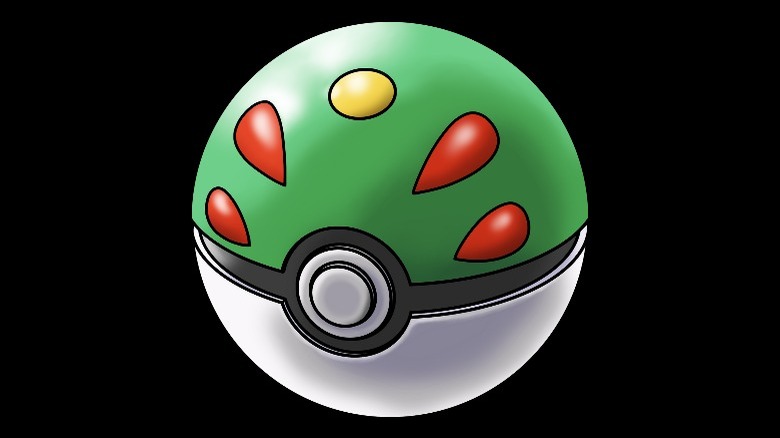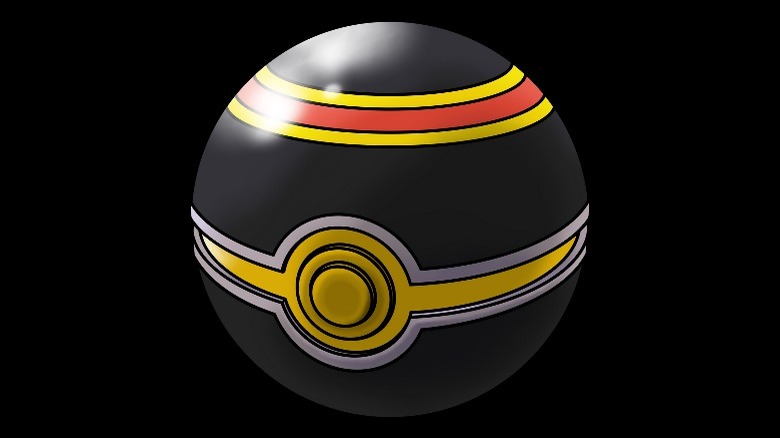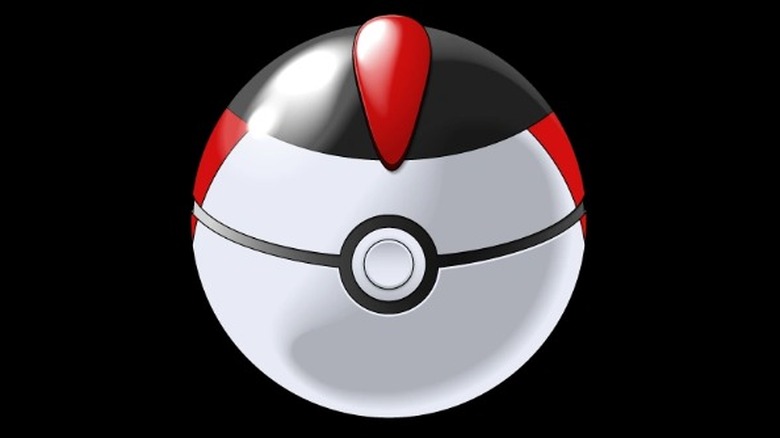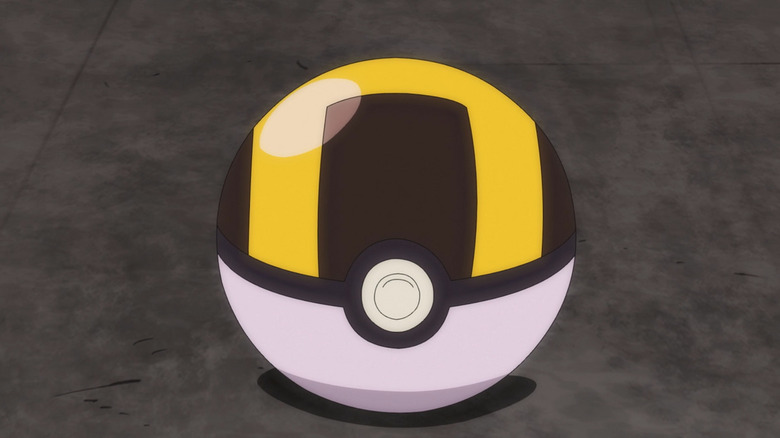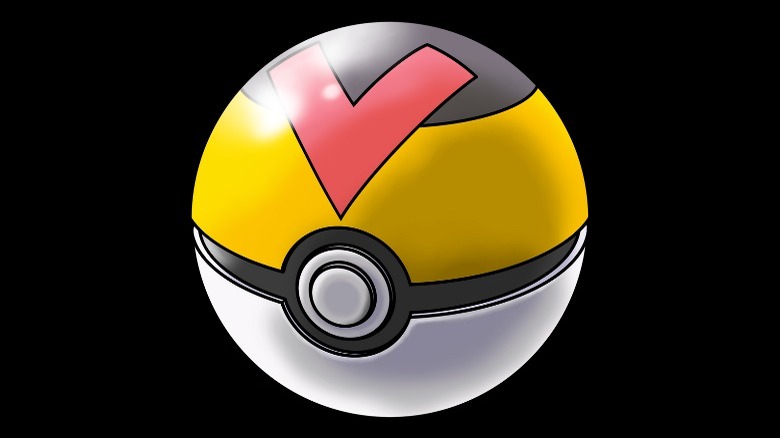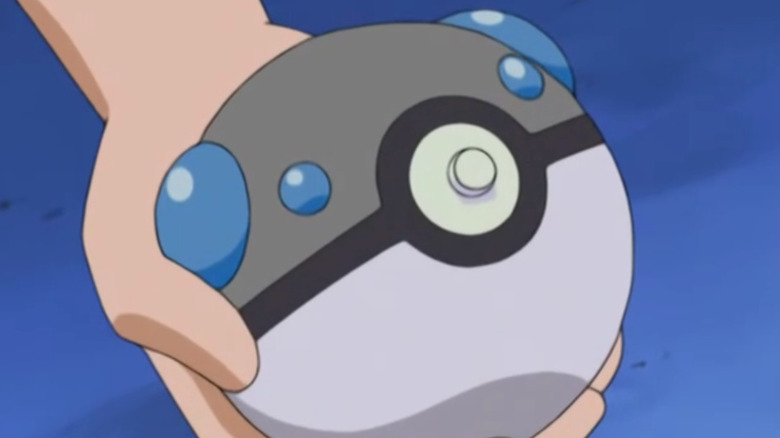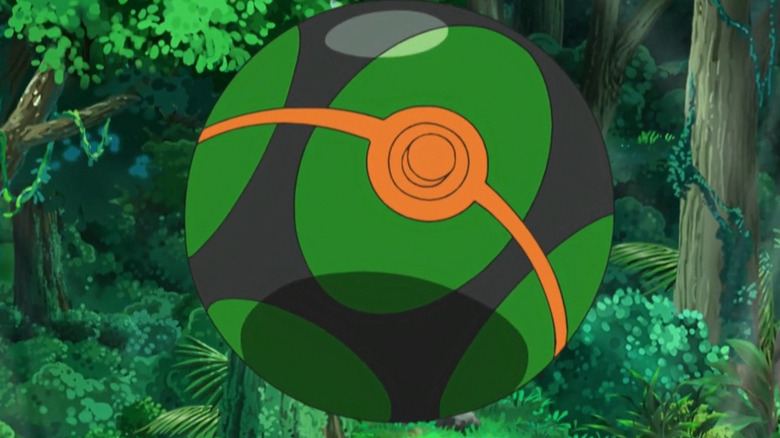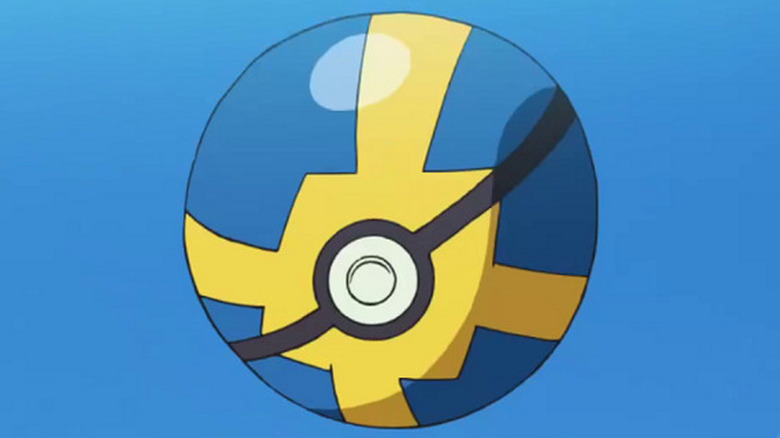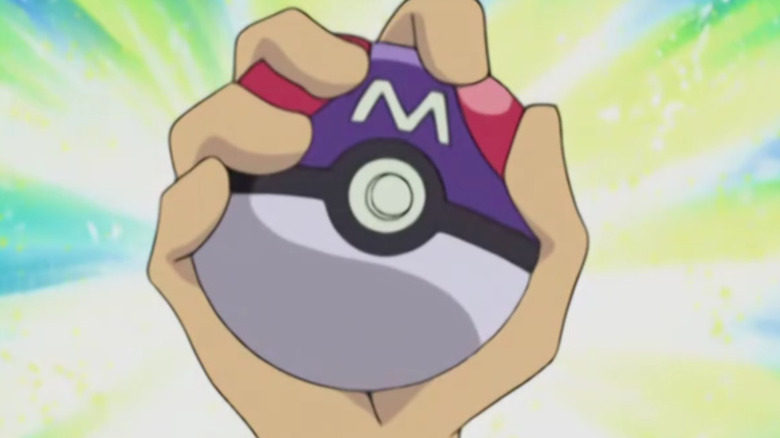Every Poké Ball Ranked Worst To First
When people think of the "Pokémon" franchise, images of Pikachu, Team Rocket, or shocking moments from the anime might pop into their heads — perhaps even the iconic red and white Poké Ball comes to mind. One of the most recognizable icons across the gaming industry, Poké Balls represent the bond between trainers and their companions and play a key role in every Pokémon adventure.
Poké Balls have gone through many iterations and innovations, with 27 different types of Poké Balls appearing across the main game series up to Generation 7's "Pokémon Sun and Moon." But which Poké Ball reigns supreme and will give players the best chance to "Catch 'Em All"? The following list offers an evaluation of each Poké Ball variety based on their strength and usefulness, while giving secondary consideration to scarcity and iconography.
27. Premier Ball
Poké Balls are the most basic catching tool within the "Pokémon" universe. Premier Balls, just like Poké Balls, give no bonuses to catching Pokémon. They function the same way as Poké Balls except they are harder to obtain.
Released in Generation 3, Premier Balls only provide a 1x catch modifier with no conditional bonuses or special effects. Players can only purchase them in "Pokémon X and Y" and "Pokémon Black and White 2" for 200 and 500 Pokémon Dollars, respectively. Commonly described as "a rare ball made in commemoration of some event," this lower-tier option is better left as a memory in the minds of trainers looking to build out their Pokémon collections.
26. Poké Ball
The original Poké Ball inspired all the other Pokémon catching and storing devices. Its red top and white bottom, intersected by a black button clasp, represents all the ball's latent technology: It can shrink or grow in size for portability, Pokémon can roll it around from the inside, and it can fully heal the Pokémon contained within when taken to a Poké Center.
As the most basic of all Poké Balls, it also has the most basic of all the bonuses: a 1x catch modifier on every Pokémon. However, it outranks the Premier Ball due to its sheer availability. Players can purchase Poké Balls in large quantities at any Poké Mart for only 200 Pokémon Dollars each. Trainers would do well to keep an emergency stash of Poké Balls as a last resort for when they've expended their supply of superior varieties.
25. Safari Ball
The Safari Zones within "Pokémon" titles offer players a unique Pokémon catching experience. For an entrance fee of 500 Pokémon Dollars, trainers receive 30 Safari Balls, a step counter, and access to rare and unique Pokémon within the area. Contrary to normal rules, trainers within the Safari Zone cannot battle the Pokémon or put them under any type of catch modifying conditions.
Unfortunately, the strength of Safari Balls leaves their effectiveness wanting. A mere 1.5x catch rate modifier on Wild Pokémon within the zone means that catching rare Safari Pokémon, which can run away at any point, turns into a tough game of chance. After Generation 8, beginning in "Pokémon Sword and Shield," players could use Safari Balls outside of the Safari Zones, but their catch rate modifier reduced to 1x everywhere, effectively making them camo-themed Poké Balls.
24. Sport Ball
The Sport Ball, an event-specific Poké Ball similar to the Safari Ball, suffers from both scarcity and a lack of effectiveness at its designated job. Unveiled in Generation 2 as the Park Ball (later renamed when a new Park Ball debuted in Generation 4), the Sport Ball can only be used in the Bug Catching Contest. The player only receives 20 Sport Balls for this challenge.
Like with the Safari Ball, "Pokémon Sword and Shield" opened up Sport Ball use in other scenarios in Generation 8. Its 1.5x catch rate modifier within the Bug Catching Contest and 1x catch modifier everywhere else in Generation 8+ games puts the Sport Ball right on par with the Safari Ball.
23. Park Ball
Of the event-specific balls, the Park Ball takes the cake in terms of uniqueness and utility. Its catch rate modifier, 255x, matches that of the legendary Master Ball, ensuring players catch their target Pokémon without fail. However, this comes with a major catch: Trainers can only use Park Balls on Pokémon transferred between Generation 3 and Generation 4 titles in Pal Park's Catching Show.
Generation 4 introduced Pal Park, a new area of the generic "Pokémon" region map that opens up after the player unlocks a National Pokédex. Trainers can catch transferred Pokémon that show up in Pal Park using one of six provided Park Balls. Despite their super strong catch rate, the fact that the player uses Park Balls to re-catch Pokémon they've already collected makes them a bit redundant.
22. Cherish Ball
Unlike all the other Poké Balls, the developers did not design the Cherish Ball for trainers to throw in an attempt to catch Wild Pokémon. Players cannot purchase the Cherish Ball in-game or obtain it through standard progression — they have to earn it through special events. Sometimes, players can unlock Event Pokémon, which come in a Cherish Ball, by completing certain requirements tied to out-of-game promotions and marketing. For example, starting in Generation 4, players could obtain Mew by transferring 999 Pokémon to "My Pokémon Ranch." Said Mew arrived in a Cherish Ball.
Despite having one of the most attractive designs, these balls effectively do nothing beyond housing special Pokémon. However, the fact that powerful and rare Pokémon (like the Legendaries) across almost every generation have come in Cherish Balls makes them more useful than the other event-specific balls.
21. Heal Ball
One of the more unique Poké Balls with special effects, the Heal Ball, unfortunately, comes in at about last place for the overall strength and usefulness of its function: fully restoring the Hit Points, status, and PP (Power Points) of the caught Pokémon. Often, trainers catch Pokémon after reducing their Hit Points and inflicting certain status effects — like Paralysis, Sleep, or Freeze — to make them easier to handle. The Heal Ball negates all the damage, status effects, and move loss that the Wild Pokémon suffered before getting caught.
While it has a nice feel to it and patches up the newly caught Pokémon, the Heal Ball has limited usefulness. Its global 1x catch rate modifier doesn't do it any favors either. With a standard catch rate and its special ability's less than optimal utility, the Heal Ball likely won't find a spot in many trainers' backpacks.
20. Great Ball
A clear upgrade from the 1x catch modifier on the standard Poké Ball, the Great Ball offers a global 1.5x catch modifier on all Pokémon no matter the region. Great Balls have been around for the franchise's full history and their cost of 600 Pokémon Dollars per ball has remained constant as well.
Part of the Great Ball's usefulness stems from its widespread availability. Every Poké Mart sells Great Balls and players generally have enough money to keep at least a few Great Balls on-hand early in each game so they don't have to rely solely on Poké Balls. The only reason it ranks so low on the list is because its next-tier sibling does everything it does but better.
19. Love Ball
The Love Ball, which debuted during Generation 2, offers one of the best catch rate modifiers of any conditional Poké Ball at a maximum of 8x. Fulfilling the conditions to reach that 8x modifier, however, makes its usefulness and effectiveness much narrower. In order to get a full 8x catch bonus, the trainer must attempt to catch a Wild Pokémon that shares the same species as the trainer's active Pokémon but has the opposite gender.
In effect, the Love Ball charms a partner for a Pokémon that the trainer already owns. If the species and gender conditions go unmet, then the Love Ball just remains a basic, 1x catch modifier ball. Trainers generally catch wild Pokémon to fill out their Pokédexes or to add them to their core team of six. Given this, they rarely need to have a second copy of a Pokémon they've already caught, making the Love Ball one of the least useful of the more powerful Poké Ball varieties.
18. Moon Ball
Another conditional ball that gives a powerful bonus but only for a small subset of Pokémon first appeared in Generation 2: the Moon Ball. This variety grants a 4x catch modifier on Pokémon that belong to an evolutionary tree that requires a Moon Stone for evolution. Unfortunately, that pool of Pokémon boasts few options, consisting of Jigglypuff, Nidorina, Nidorino, Clefairy, Skitty, Munna, and all of their evolutions. Even so, The 4x catch rate modifier and easy access to the ball through a repeatable quest makes the Moon Ball a decent choice for it designed purpose.
When the Moon Ball debuted in Generation 2 as part of "Pokémon Gold, Silver, and Crystal," a bug in the code prevented it from working as intended. Instead of searching for the Moon Stone requirement, the code checked if the targeted Wild Pokémon had an evolutionary tree influenced by the medicine Burn Heal, which no Pokémon has given the nature of the item. So, in Generation 2, the Moon Ball only conferred a 1x catch rate.
17. Dream Ball
One of the newest additions to the Poké Ball roster, Dream Balls first appeared in Generation 5 before getting a design update in Generation 8. In "Pokémon Black and White," players could not obtain Dream balls through a normal method due to their inclusion in a specific event. When players went into Entree Forest, they had a special interaction with the Wild Pokémon they encountered and could catch it without battling it. This interaction placed a single Dream Ball in the player's bag that guaranteed a catch in Entree Forest. However, if they didn't use the Dream Ball in the encounter, it disappeared permanently from their bag.
In Generation 8, Dream Balls changed to give a 4x catch modifier on sleeping Pokémon and became easily attainable through Max Raid Battles. Its current form makes the Dream Ball quite useful because players already want to have their targeted Wild Pokémon in the Sleep status effect, so stacking those synergistic and common sense modifiers makes the Dream Ball a great choice.
16. Dive Ball
Generation 3 introduced many type-specific Poké Balls that give catch rate modifier bonuses, such as the Dive Ball. In Generation 3, the Dive Ball provided a 3.5x catch rate modifier on Pokémon encountered while underwater. "Pokémon FireRed and LeafGreen," part of the Generation 3 roster, had no underwater sequences in them; therefore, the Dive Ball only reached a 1x max catch rate modifier in those games.
The Dive Ball evolved for Generation 4 and onward to include its current 3.5x catch rate modifier on Wild Pokémon encountered while fishing, surfing, or underwater. Trainers run into many useful water-type Pokémon through fishing or surfing, so the Dive Ball makes for a handy addition to any sea-faring adventure.
15. Net Ball
Offering similar benefits to the Dive Ball, the Net Ball barely outperforms its relative due to an expanded list of catchable Pokémon. Just like the Dive Ball, the Net Ball provides a 3.5x catch rate modifier (starting in Generation 7) on qualifying Pokémon. But, instead of only working on Pokémon met through water-based encounters, the Net Ball gets the modifier bonus when catching all water-type and bug-type Pokémon.
Almost all the Pokémon encountered while fishing, surfing, and underwater are water-type, so the Net Ball does the same job as the Dive Ball but better because of its additional bug-type modifier. Catching bug-type Pokémon, however, generally doesn't matter because they are among the weakest in the game. However, players can make quick work of filling their Pokédexes with bug-types thanks to the Net Ball.
14. Nest Ball
The Nest Ball offers one of the most unique experiences due to its dynamic nature. One of the only Poké Balls that boasts a formula used to calculate its catch rate modifier, the effectiveness of the Nest Balls shifts depending on the level of the Wild Pokémon targeted by the trainer.
While the Nest Ball's formula looks complex, its outcome relies on the target Pokémon falling between levels 1-29. The common breakpoints for catch rate modifiers are: 4x for a Level 1 Pokémon, 3.5x for a level 6 Pokémon, 3x for a level 11 Pokémon, and so on, resulting in a 1x modifier for all Pokémon above level 29. With most Pokémon caught in those level ranges, the Nest Ball offers decent compensation for its expensive 1,000 Pokémon Dollars price point.
13. Repeat Ball
A relative of the Love Ball, the Repeat Ball also determines its catch bonus by checking the player's Pokédex for Pokémon they've previously caught. The Repeat Ball provides a strong 3.5x catch modifier for Pokémon the trainer has "already registered as owned" in their Pokédex.
Repeat Balls have quite a lot of utility for their conditional requirement. Players will find them especially useful for catching shiny Pokémon. In fact, they're so good at this task that some fans have taken to disliking the Repeat Ball because so many cool Pokémon end up housed in the rather mundane-looking container. As a result, trainers interested in trading may want to avoid using Repeat Balls on more prestigious Pokémon altogether.
12. Lure Ball
The Lure Ball might just be the best bet for catching most water-based Pokémon because of its 4x catch rate modifier for Pokémon encountered while fishing. While the Lure Ball doesn't get the added bug-type condition that the Net Ball has, it makes up for that type deficiency by providing a massive 4x catch rate modifier on perhaps the strongest and broadest Pokémon type: water.
Besides Legendaries such as Kygore, trainers can encounter all the water-type Pokémon they could want while fishing. Players looking to fill out their Pokédexes should keep a nice stash of Lure Balls ready for fishing in the many different areas of each region.
11. Fast Ball
Like a few of its brethren, the Fast Ball didn't work as intended when it debuted in Generation 2 due to a bug. Though the developers designed this iteration to give a 4x boosted catch rate against Pokémon likely to flee, the code only checked Magnemite, Grimer, and Tangela. No other Pokémon received the 4x catch modifier outside of that short list — not even if they met the requirements.
From Generation 4 onward, the developers changed the Fast Ball to give a 4x catch rate modifier when used against Pokémon with a Speed stat of 100 or greater. Most low level Pokémon won't satisfy this condition, but some of the strongest and more rare Pokémon players encounter as they progress through each game surpass 100 Speed.
10. Beast Ball
The Beast Ball stands out from other Poké Balls, boasting an effect that no other variety replicates. Introduced in Generation 7, the Beast Ball is the only option that gives a substantial catch bonus against Ultra Beasts.
In contrast to all the other balls (except the Master Ball), which grant a 0.1x catch rate modifier on Ultra Beast Pokémon, the Beast Ball provides a 5x catch rate bonus. On the flipside, Beast Balls boast a 0.1x catch rate modifier for all Pokémon other than Ultra Beasts. Therefore, the only way to catch Ultra Beasts is with Beast Balls. Also, its visual design distinguishes it, further supporting its unique purpose.
9. Friend Ball
Another stand-out for its specific use case, the Friend Ball provides juicy friendship points often hard to come by in Pokémon games. Even though it only has a 1x catch rate modifier, the same strength as a basic Poké Ball, it gives 200 friendship points (changed to 150 for Generation 8) to Pokémon caught with it — a valuable advantage in certain scenarios.
18 different Pokémon require a friendship level of above 220 to evolve, with classics like Eevee and Pichu's evolutions locked behind their happiness levels. This makes the Friend Ball a necessity for evolving the Pokémon on that list. Players must trade a Green Apricorn for each Friend Ball, making them a powerful and rare commodity best saved for the right situation.
8. Luxury Ball
The fanciest-sounding of the Poké Balls, the Luxury Ball apparently lets the caught Pokémon enjoy the finer things in life. Introduced in Generation 3, the ball has a similar effect to the Friend Ball. But, instead of automatically increasing the friendship level of the caught Pokémon to 200, the Luxury Ball doubles the rate of friendship gained by the caught Pokémon.
At the outset, the Luxury Ball does not quite stack up to the instant payoff that the Friend Ball provides. However, thanks to the ease of acquisition, players have access to a large supply of Luxury Balls for the cost of 1,000 Pokémon Dollars each. Its sleek design also stands out amongst other Poké Balls, allowing the Luxury Ball to live up to its name.
7. Timer Ball
Generation 3 boasted many Poké Ball innovations, with the Timer Ball offering yet another unique take. This variety provides a catch rate modifier that increases the longer the encounter lasts. On turn 1 of a Wild encounter, the Timer Ball has a normal 1x catch rate modifier, but it ramps up to a maximum of a 4x catch rate modifier on turns 10 and above.
Without any other conditions to meet, piled on top of its widespread availability, the Timer Ball is one of the best options in any situation. Unless they want to catch a Pokémon on the first turn, players typically spend some time lowering a Wild Pokémon's HP while also applying a status effect. With that natural progression, the Timer Ball fits right in and serves up great utility in nearly every scenario.
6. Ultra Ball
The best of the basic trio from the Generation 1 games, the Ultra Ball shines as the epitome of affordable consistency. It only gives a 2x catch rate modifier, which, compared to other high ranking Poké Balls, is quite low. However, it doesn't require that the player or targeted Pokémon meet a specific condition, making it ideal to always have a stash of 99+ of them on hand.
For the Pokémon trainer who doesn't want or need to max out their Pokémon-catching efficiency, the Ultra Ball serves all their needs. No fuss, no strings attached, just a raw 2x bonus makes the Ultra Ball the bread and butter of generic Poké Balls.
5. Level Ball
The Level Ball provides a catch bonus modifier based on the level of the Pokémon the trainer is currently using. Starting at a 1x catch rate modifier for Wild Pokémon with a level equal to or greater than the trainer's Pokémon, the Level Ball ramps up from there to a maximum of an 8x catch rate modifier for Wild Pokémon at a ¼ of the level of the trainer's Pokémon.
For example, if the trainer uses a level 99 Pokémon, as is very common in the late game, then all Pokémon level 24 and below will have an 8x catch rate modifier when targeted by a Level Ball. This is in league with the highest catch rate modifiers in the game outside of automatic-catch balls, making the Level Ball one of the best additions to any collection.
4. Heavy Ball
The Heavy Ball has one of the most difficult to calculate bonuses, but in general, it works according to its name: throw it at heavy-weighted Pokémon. It is, in fact, the only formula that relies on addition instead of a multiplicative modifying factor. For example, for Pokémon that weigh 225.5 lbs. or less, a -20 modifier is applied for the catch rate. On the flip side, for Pokémon that weigh 903 lbs. or more, then a flat +40 is added to the catch rate.
Without getting too into the weeds with math, the Heavy Ball interacts best with larger and more elusive Pokémon due to the way its addition-based formula corresponds to catch rate difficulty. Heavy Balls are so good at catching rare, heavy Pokémon that they can even have the highest catch rate modifiers in the game.
3. Dusk Ball
Most unique Poké Balls don't offer flexibility across many different types of situation, making the Dusk Ball something of an exception. An even better version of the Ultra Ball, the Dusk Ball provides a 3x catch rate modifier for Pokémon caught either in a cave or at night.
While the cave component doesn't boast as much use as the global nighttime modifier, players should not have much trouble fulfilling this combination of conditions. Trainers who want to stock up on strong Poké Balls that provide a 3x catch rate modifier for basically any Pokémon (and who don't mind battling after nightfall) can't go wrong with the Dusk Ball.
2. Quick Ball
The Quick Ball does just about everything a trainer looking to catch Pokémon in a hurry could want. With a simple 5x catch rate modifier on the first turn of a Wild encounter only, the Quick Ball does not have any hard hoops to jump through to unlock its high catch rate bonus.
Players after the most efficient and relatively easy to obtain option should look no further than the Quick Ball. In fact, the Quick Ball is so strong that Reddit community members have generated breakdowns of their success rates ("94 out of 100" catches in one case) using this variety, with some even coming to the conclusion that the Quick Ball is too good at what it does. Providing an optimal choice for the first turn of every encounter makes the Quick Ball one of the best.
1. Master Ball
While most other Poké Balls need to follow some sort of rule or fulfill a conditional guideline, the Master Ball eschews convention in favor of raw power. Just about everybody familiar with the "Pokémon" franchise knows that the Master Ball automatically catches any Pokémon it gets thrown at. No ifs, ands, or buts about it: the Master Ball always accomplishes its task with a 255x catch rate modifier.
As players can only obtain one Master Ball per playthrough, some people design their entire run around the Pokémon they will use their Master Ball on. Chucking a Master Ball at a Legendary Pokémon in the late game can feel fantastic, like the player has truly mastered the art of being a Pokémon trainer.

